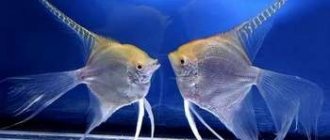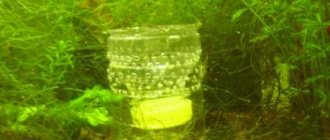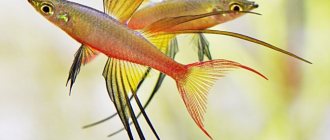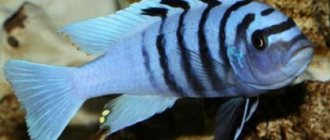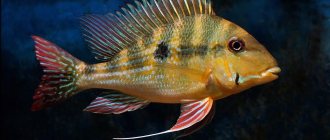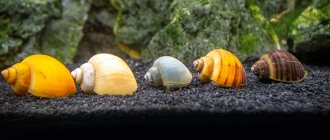Pseudotropheus lombardoi (Latin: Pseudotropheus lombardoi, Maylandia lombardoi) is a cichlid living in Lake Malawi, belonging to the aggressive species of mbuna. In nature they grow up to 13 cm, and in an aquarium they can be even larger. What makes Lombardo quite unique is that the coloring of the male and female is so different that it looks like two different species of fish. The male is orange with pale dark stripes on the upper back, while the female is bright blue with more pronounced stripes.
Moreover, this coloration is opposite to the usual coloration of other mbuna; in nature, most species have blue males and orange females.
Since these are one of the most aggressive African cichlids, they are recommended for experienced aquarists to keep.
They are very warlike, even a fry a couple of centimeters long can and wants to destroy small fish, such as guppies. They are definitely not suitable for community aquariums, but they are suitable for cichlids.
Habitat in nature
Pseudotropheus Lombardo was described in 1977. It lives in Lake Malawi, in Africa, initially near Mbenji Island and Nktomo Reef, but now also near Namalenji Island.
They prefer to live at depth (from 10 meters or more), in places with a rocky or mixed bottom, for example, in sandy or muddy places between stones.
Males guard a hole in the sand, which they use as a nest, and females, nestless males and juveniles often live in migrating flocks.
The fish feed on zoo and phytoplankton, but their diet mainly consists of algae growing on rocks.
What to feed
Pseudotropheus lombardo can consume several types of food, among which the most suitable for it are:
- flakes based on spirulina, with the addition of vegetables;
- frozen krill and bloodworms (uncommon);
- plants: spiral and giant Vallisneria, Carolina cabomba, polyspermous hygrophila (all of them quickly fade and can significantly diversify the diet of fish).
Under no circumstances should you give your aquarium pets any kind of raw meat, as their digestive system will not be able to handle such food.
Keeping in an aquarium
The minimum recommended aquarium volume for a male and several females is 200 liters. In a larger aquarium you can already keep them with other cichlids.
Since in nature, in Lake Malawi, the water is alkaline and hard, this imposes restrictions on the content of Lombardo.
This water is suitable for a small number of fish and plants. Parameters for maintenance: temperature 24-28 °C, pH: 7.8-8.6, 10 - 15 dGH.
In regions with soft and acidic water, such parameters will become a problem, and aquarists have to resort to tricks, for example, adding coral chips or eggshells to the soil.
When it comes to soil, the best solution for Malawians is sand.
They love to dig in it and regularly dig up plants, at the same time depriving them of leaves. So you can completely abandon plants in an aquarium with pseudotropheus.
An exception may be hard-leaved species such as Anubias. Another advantage of sand is that it is easy to siphon, and this must be done often so that ammonia and nitrates, to which fish are sensitive, do not accumulate.
Naturally, the water in the aquarium needs to be changed weekly and it is highly advisable to use a powerful external filter.
Pseudotropheus Lombardo needs a lot of shelters: rocks, caves, pots and driftwood. Be careful, as fish can dig up the soil underneath them and this will lead to the collapse of the decor.
Description
The zebra cichlid has a typical mbuna body, strong and elongated, although males appear slightly wider than females. They usually grow up to 12 cm or a little more in length. With proper care, it can live for 10 years in a home aquarium.
Male
The male is golden yellow with very pale (sometimes barely visible) vertical stripes. The belly area is lighter in color and there are testicle-shaped spots on the anal fin. Females are blue-violet with the same stripes and a light belly. Juveniles are similar to females, but smaller in size.
Female
Nutrition
The diet is varied. Lombardo cichlids will accept all types of popular foods (dry, frozen and live). The only important condition is the addition of herbal supplements. They can be kept together with dry food, or added separately. Spirulina flakes or pieces of nori work great.
Our product Aqvium natural dry food for small and medium fish from clean lakes of Siberia and Northern Crimea in environmentally friendly biodegradable packaging.
Find out more
Male and female Lombardos
You can distinguish a male from a female by coloring. Typically, dominant mature males are yellow in color, while females are blue. However, many males occupying lower levels in the hierarchy acquire a blue coloration, like that of females. In turn, females carrying young in their mouths may be yellow, making them difficult to distinguish from males.
Above is a photo of males of Pseudotropheus lombardo, and below is a photo of females
The size of adult males reaches 15 cm, while females are only 14 cm.
Diseases
Pseudotropheus lombardo is a hardy species with good immunity. However, you may encounter the following diseases:
- Fungal infections.
- Viral infections.
- Bacterial infections.
- Ulcers on the body of fish.
- Obesity.
The diseases are manifested by lethargy, apathy of the fish, and sometimes the appearance of spots on their body. In any case, the first thing you need to do is change the aquarium water by 25-30% and contact a specialist. He will prescribe a course of medications. If you are obese, you need to reconsider your diet and diet.
Best neighbors
- Lombardo has an aggressive character. Even young fish show courage and strive to destroy smaller neighbors - for example, guppies. The females of the pack have a more peaceful disposition.
- This type of cichlid is not suitable for general aquariums. It is safest to keep fish with other cichlids, with the exception of peaceful species - for example, Labidochromis yellow.
- The best neighbors will be other representatives of the Mbuna eco-group. But then the volume of the aquarium must be at least 400 liters. In a small tank there is not enough space at the bottom to form a “security” area. Therefore, clashes between males will become commonplace.
- Lombardo should not be placed with fish that live in an aquarium with soft, slightly acidic water. Representatives of Mbuna often get sick due to disturbances in the hydrochemical composition of the environment.
Feed and feeding
Pseudotropheus lombardo is an omnivorous aquarium fish that in nature primarily prefers algae, which also contains crustaceans, larvae and other organisms, as well as plankton.
The aquarium will have high quality dry food, in the form of flakes or pellets, spirulina and other foods for omnivorous cichlids. Suitable live and frozen foods include bloodworms, brine shrimp, daphnia, shrimp and small shrimp and fish such as guppies. You can diversify your diet with plant foods such as spinach, zucchini and peas.
It is better to feed several times a day in small portions than once in large portions. It is useful to add additional vitamins to the water.
Breeding/reproduction
Breeding is possible in a community aquarium. With the onset of the mating season, the male chooses a place for future spawning. It is a depression in the sand or a simple flat stone. During this period, the male becomes overly aggressive, and his courtship may seem overly persistent and rude. That is why places for shelters are needed. When the female is ready, she accepts courtship and lays portions of eggs, which after fertilization she immediately takes into her mouth. Further, the entire incubation period will take place in the female’s mouth. This is an evolutionarily established mechanism for protecting future offspring, characteristic of the cichlids of Lake Malawi.
Compatibility
When adding neighbors, you need to take into account that these cichlids have an aggressive nature. Therefore, pseudotropheus compatibility is not the easiest task. Males are especially hostile. They fiercely defend their territory from everyone and can attack their relatives. Some subspecies are not so aggressive. However, in general, experts recommend placing about four females with one male.
Neighborhood is possible only with other representatives of Lake Malawi, similar in size. Small, even predatory fish, will eventually become food. Pseudotropheus coexists with labidochromis, melanochromis, and labeotropheus. It is possible to replant labeo, barbs, astronotus, and some catfish. Under no circumstances should you add angelfish, discus fish, koi carps, goldfish, corydoras, swordtails, etc.
Pseudotropheus Lombardo: maintenance, breeding, compatibility, video
Conditions of detention
You can keep a group of Pseudotropheus Lombardo , including several females and 1 male, in a general aquarium from 120 cm long in the vicinity of peace-loving cichlids of the island. Malawi. This proximity somewhat reduces the aggressiveness of Pseudotropheus Lombardo. Territorial and aggressive towards other fish (of their own species and having a similar color), males of Pseudotropheus Lombardo stay near the bottom and in the middle layer of water. It is preferable to take the volume of the aquarium based on 2 liters of water per 1 cm of fish length.
The aquarium is filled with stone structures almost reaching the surface of the water, imitating a rocky landscape, with flat stones. Structures made of stones should have shelter caves. Among aquarium plants, you can plant large-leaved specimens, for example, cryptocorynes or anubias. Maintenance conditions: water with a temperature of 25-27°C, a total hardness of 8 to 20° and an acidity index of 7.5-8.5, as well as the presence of filtration, aeration and weekly replacement of 25-30% of fresh water with the same parameters. Despite the great ability of cichlids o.
Malawi adapt to living conditions; when maintaining them, you need to pay special attention to the pH value. Experience shows that when the pH deviates to the alkaline region, fish tolerate both hard and soft water well, but attempts to keep cichlids in acidic soft water do not give positive results. Also, when keeping Pseudotropheus Lombardo and cichlids together. In Malawi, the optimal water temperature is 26°C. Particular attention should be paid to the removal of fish waste products and food residues, because ammonia is formed in an alkaline environment during the nitrification process.
According to experienced aquarists, add 5-6 tsp to the water. baking soda and 60-80 g of sea salt or, in extreme cases, table salt will have a beneficial effect on fish. The diet of Pseudotropheus Lombardo consists of 60-80% plant food and 20-40% live food; it can be fed with substitutes. It is recommended to plant plants whose leaves quickly wither and become flabby, for example, hygrophila, cabomba, limnophila and vallisneria. They serve as additional food for fish.
Breeding
Egg-laying, the female lays eggs and then immediately takes them into her mouth, where the male fertilizes them. Nature has cleverly arranged it so that the yellow spots on the male’s anal fin remind the female of eggs, which she tries to peck and take into her mouth for another egg. However, in this way it only stimulates the male to release milk, which, together with the flow of water, enters the female’s mouth and thus fertilizes the eggs. As a rule, Lombardo pseudotropheus spawn in the same aquarium in which they live.
The male digs a hole in the ground where the clutch will be located before the female takes it. The female with eggs in her mouth hides in a shelter and refuses food. She carries about 50 eggs for 3 weeks. The emerging fry is completely ready for life and the starting food for it is Artemia naupilia, brine shrimp, and daphnia. It is possible to increase survival rate in a community aquarium by providing secluded places for the fry that are inaccessible to other fish.
Compatibility
It is best kept in a group of one male and several females, in a spacious aquarium. The male does not tolerate it and will attack any other male or fish similar in appearance to him. It is best to keep them with other mbuna, and avoid peaceful cichlids such as Labidochromis yellow.

